 |
 |
Our enthusiastic and extremely knowledgeable perennials team is here to answer your questions and help you choose the best perennials for your situation. There’s always something in bloom for sun, shade, butterflies, birds or deer resistance as well as a variety of bulbs for your space.
Stroll through our time-tested favorites and introduce yourself to the newest varieties. We garden with perennials too; we love them and it shows!
|
28 found, showing page 1 of 2
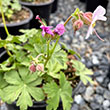
Long-lasting white flowers with a pink blush in the center, bloom from mid-spring to mid-summer. Great as a groundcover. Naturalizing. USDA 5-8

Pink blooms. Self-seeding groundcover. Tolerates clay. USDA 3-8
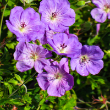
Violet blue flowers. Very beautiful groundcover, border plant or along a walkway. Tolerant of heat and humidity. USDA 5-8
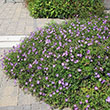
Violet blue flowers. Very beautiful groundcover, border plant or along a walkway. Tolerant of heat and humidity. USDA 5-8

Attractive verigated grass-like foliage and large, spectacular pale blue blooms. USDA 4-9
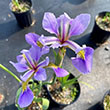
Purple-blue blooms. Tolerates standing water. Native. USDA 3-9
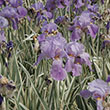
Pale blue blooms. Fragrant. Cream & green variegated foliage. USDA 4-9
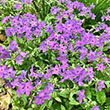
Plant Height: 6 inches
Flower Height: 8 inches
Spacing: 10 inches
Sunlight: partial shade full shade
Hardiness Zone: 2a
Other Names: Creeping Phlox
Ornamental Features:
Sherwood Purple Woodland Phlox is draped in stunning cymes of lightly-scented indigo star-shaped flowers at the ends of the stems from early spring to early summer. Its tiny narrow leaves remain green in color throughout the year.
Landscape Attributes:
Sherwood Purple Woodland Phlox is a dense herbaceous evergreen perennial with a ground-hugging habit of growth. It brings an extremely fine and delicate texture to the garden composition and should be used to full effect.
This plant will require occasional maintenance and upkeep, and should be cut back in late fall in preparation for winter. Deer don't particularly care for this plant and will usually leave it alone in favor of tastier treats. Gardeners should be aware of the following characteristic(s) that may warrant special consideration:
- Spreading
Sherwood Purple Woodland Phlox is recommended for the following landscape applications:
- Mass Planting
- Rock/Alpine Gardens
- Border Edging
- General Garden Use
- Groundcover
- Container Planting
Planting & Growing:
Sherwood Purple Woodland Phlox will grow to be only 6 inches tall at maturity extending to 8 inches tall with the flowers, with a spread of 12 inches. When grown in masses or used as a bedding plant, individual plants should be spaced approximately 10 inches apart. Its foliage tends to remain low and dense right to the ground. It grows at a medium rate, and under ideal conditions can be expected to live for approximately 10 years. As an evegreen perennial, this plant will typically keep its form and foliage year-round.
This plant does best in partial shade to shade. It does best in average to evenly moist conditions, but will not tolerate standing water. It is not particular as to soil type, but has a definite preference for acidic soils. It is highly tolerant of urban pollution and will even thrive in inner city environments. Consider covering it with a thick layer of mulch in winter to protect it in exposed locations or colder microclimates. This is a selection of a native North American species. It can be propagated by division; however, as a cultivated variety, be aware that it may be subject to certain restrictions or prohibitions on propagation.
Sherwood Purple Woodland Phlox is a fine choice for the garden, but it is also a good selection for planting in outdoor pots and containers. Because of its spreading habit of growth, it is ideally suited for use as a 'spiller' in the 'spiller-thriller-filler' container combination; plant it near the edges where it can spill gracefully over the pot. Note that when growing plants in outdoor containers and baskets, they may require more frequent waterings than they would in the yard or garden.
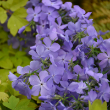
Height: 12 inches
Spacing: 10 inches
Sunlight: partial shade, full shade
Hardiness Zone: 4a
Other Names: Woodland Phlox
Description:
A choice variety with overlapping petals of passionate blue fragrant flowers that bloom early and persist; a wonderful plant for borders and edging; not prone to mildew, and grows best in slightly dry conditions
Ornamental Features:
Blue Moon Phlox is smothered in stunning lightly-scented blue star-shaped flowers at the ends of the stems from mid to late spring. Its narrow leaves remain green in color throughout the season.
Landscape Attributes:
Blue Moon Phlox is a dense herbaceous perennial with a mounded form. Its relatively fine texture sets it apart from other garden plants with less refined foliage.
This plant will require occasional maintenance and upkeep, and should be cut back in late fall in preparation for winter. Deer don't particularly care for this plant and will usually leave it alone in favor of tastier treats. Gardeners should be aware of the following characteristic(s) that may warrant special consideration:
- Spreading
Blue Moon Phlox is recommended for the following landscape applications:
- Mass Planting
- Border Edging
- General Garden Use
- Groundcover
Planting & Growing:
Blue Moon Phlox will grow to be about 12 inches tall at maturity, with a spread of 12 inches. When grown in masses or used as a bedding plant, individual plants should be spaced approximately 10 inches apart. Its foliage tends to remain dense right to the ground, not requiring facer plants in front. It grows at a fast rate, and under ideal conditions can be expected to live for approximately 10 years. As an herbaceous perennial, this plant will usually die back to the crown each winter, and will regrow from the base each spring. Be careful not to disturb the crown in late winter when it may not be readily seen!
This plant does best in partial shade to shade. It does best in average to evenly moist conditions, but will not tolerate standing water. It is not particular as to soil type or pH. It is quite intolerant of urban pollution, therefore inner city or urban streetside plantings are best avoided, and will benefit from being planted in a relatively sheltered location. Consider applying a thick mulch around the root zone over the growing season to conserve soil moisture. This is a selection of a native North American species. It can be propagated by division; however, as a cultivated variety, be aware that it may be subject to certain restrictions or prohibitions on propagation.

Pink blooms with hints of purple. Mounded, spreading habit. USDA 4-7
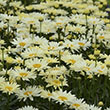
Height: 18 inches
Spacing: 18 inches
Sunlight: full sun, partial shade
Hardiness Zone: 4a
Group/Class: Amazing Daisies Collection
Brand: Proven Winners
Description:
An outstanding shasta daisy with large lemon blooms that mature to creamy white, with golden centers; vigorous, with an extra long bloom time, and disease resistant foliage; a beautiful addition to the garden when massed
Ornamental Features:
Amazing Daisies Banana Cream Shasta Daisy has masses of beautiful lemon yellow daisy flowers with gold eyes at the ends of the stems from early to late summer, which are most effective when planted in groupings. The flowers are excellent for cutting. Its serrated narrow leaves remain dark green in color throughout the season.
Landscape Attributes:
Amazing Daisies Banana Cream Shasta Daisy is an herbaceous perennial with an upright spreading habit of growth. Its medium texture blends into the garden, but can always be balanced by a couple of finer or coarser plants for an effective composition.
This plant will require occasional maintenance and upkeep, and should be cut back in late fall in preparation for winter. It is a good choice for attracting butterflies to your yard. Gardeners should be aware of the following characteristic(s) that may warrant special consideration:
- Insects
Amazing Daisies Banana Cream Shasta Daisy is recommended for the following landscape applications:
- Mass Planting
- Border Edging
- General Garden Use
- Container Planting
Planting & Growing:
Amazing Daisies Banana Cream Shasta Daisy will grow to be about 15 inches tall at maturity, with a spread of 24 inches. When grown in masses or used as a bedding plant, individual plants should be spaced approximately 18 inches apart. It grows at a fast rate, and under ideal conditions can be expected to live for approximately 5 years. As an herbaceous perennial, this plant will usually die back to the crown each winter, and will regrow from the base each spring. Be careful not to disturb the crown in late winter when it may not be readily seen!
This plant does best in full sun to partial shade. It does best in average to evenly moist conditions, but will not tolerate standing water. It is not particular as to soil type or pH. It is highly tolerant of urban pollution and will even thrive in inner city environments. This particular variety is an interspecific hybrid. It can be propagated by division; however, as a cultivated variety, be aware that it may be subject to certain restrictions or prohibitions on propagation.
Amazing Daisies Banana Cream Shasta Daisy is a fine choice for the garden, but it is also a good selection for planting in outdoor pots and containers. It is often used as a 'filler' in the 'spiller-thriller-filler' container combination, providing a mass of flowers against which the larger thriller plants stand out. Note that when growing plants in outdoor containers and baskets, they may require more frequent waterings than they would in the yard or garden.
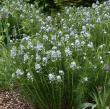
Long-lived plant with clusters of blue flowers in May and June and golden fall color on an upright, bushy plant. USDA 5-8
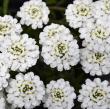
White blooms. Uniform mounding evergreen groundcover. USDA 4-8
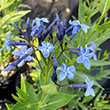
Native clump-forming slow speading groundcover. Blue spring flowers, feathery green summer foliage, and golden fall color. USDA 5-9
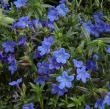
Bright purpley blue blooms. Deep green foliage. Groundcover. USDA 6-8
28 found, showing page 1 of 2












